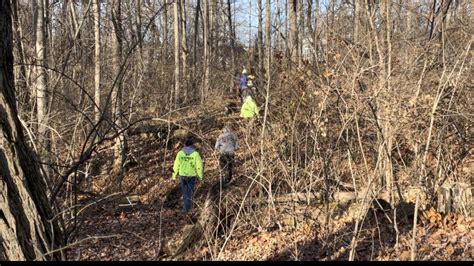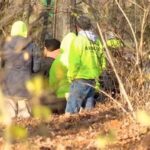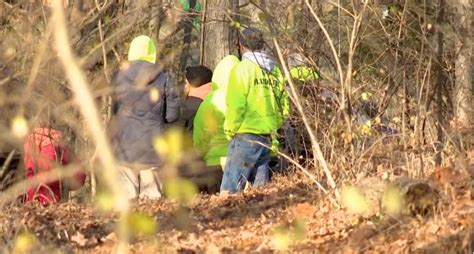
Human and animal bones were discovered in a creek near the former property of Herb Baumeister, a man suspected of being a serial killer who targeted gay men in the 1990s, reigniting interest in the decades-old case.
CARMEL, Ind. — Investigators are meticulously examining human and animal bones recovered from a creek adjacent to the former estate of Herbert Baumeister, a prime suspect in a string of unsolved murders from the 1990s, Hamilton County Coroner Jeff Jellison confirmed on Wednesday. The discovery occurred near Fox Hollow Farm, the 18-acre property once owned by Baumeister, who fled to Canada and took his own life in 1996 as authorities closed in on him. The renewed investigation seeks to potentially link Baumeister to additional victims beyond the remains already identified.
“We were contacted last week about bones that were found in a creek…near the Baumeister property,” Jellison stated. “We responded to the scene and confirmed that there were bones. We were able to collect a number of bones from that creek.”
The bones are undergoing forensic analysis to determine their origin – whether they are human or animal – and to ascertain if the human remains can be linked to any of the previously unidentified victims connected to Baumeister. The Indiana State Police are assisting with the investigation, bringing in additional resources and expertise to meticulously comb the area and process the evidence.
Baumeister, a wealthy businessman who owned the successful Sav-A-Lot thrift stores, became the focus of a murder investigation after police began investigating the disappearances of gay men from Indianapolis in the early to mid-1990s. Detectives suspected that Baumeister lured the men to his sprawling estate under false pretenses.
In 1996, investigators, acting on a tip from Baumeister’s estranged wife, Judith, obtained a search warrant for Fox Hollow Farm. During the search, investigators discovered the cremated remains of at least eight men scattered across the property. Baumeister, fearing arrest and prosecution, fled to Canada shortly before the search warrant was executed. He committed suicide by gunshot in a park near Toronto before he could be apprehended.
Despite the discovery of remains on his property, Baumeister was only ever officially linked to the remains of eleven men. However, investigators have long suspected that he may have been responsible for more deaths, potentially dozens more. The current discovery has sparked renewed hope that additional victims might finally be identified and brought closure to their families.
Hamilton County Sheriff Dennis Quakenbush noted the significance of the renewed search. “This is a very important case for our community, and we are dedicated to following every lead and uncovering every piece of evidence,” he stated in a press release. “We understand the pain and suffering that the families of the victims have endured, and we are committed to bringing them justice.”
The investigation is being conducted with meticulous care, employing modern forensic techniques that were not available during the initial investigation in the 1990s. These techniques include advanced DNA analysis and forensic anthropology, which can provide insights into the age, sex, and possible cause of death of the individuals whose remains are being examined.
Judith Baumeister, Herb Baumeister’s former wife, played a crucial role in the initial investigation. She provided investigators with key information about her husband’s strange behavior and his obsession with the property. She also recounted instances where she found bone fragments and unusual objects on the estate, but she initially dismissed them as animal remains. However, as the disappearances of gay men continued, she grew increasingly suspicious of her husband’s activities. Her cooperation with the police proved instrumental in obtaining the search warrant that led to the discovery of the cremated remains.
The case of Herb Baumeister has remained a chilling reminder of the dark side of human nature and the devastating impact of serial violence. The discovery of the bones in the creek has reopened old wounds and rekindled the hope for justice among the families of the victims who have been waiting for answers for decades.
The current investigation is expected to take several weeks, if not months, to complete. The bones will be sent to forensic laboratories for analysis, and investigators will continue to search the area for additional evidence. The Hamilton County Coroner’s Office is working closely with the Indiana State Police and other law enforcement agencies to ensure that the investigation is conducted thoroughly and professionally.
The story of Herb Baumeister is a complex one, marked by wealth, deception, and unimaginable cruelty. His ability to lead a double life, maintaining a successful business while simultaneously preying on vulnerable individuals, highlights the insidious nature of serial killers. The renewed investigation into his crimes serves as a reminder of the importance of vigilance and the need to hold perpetrators of violence accountable for their actions, no matter how long it takes.
The investigation into the Baumeister case remains open and ongoing. Authorities encourage anyone with information about the case to come forward and contact the Hamilton County Sheriff’s Office or the Indiana State Police. Even seemingly insignificant details could potentially provide valuable leads and help bring closure to the families of the victims.
The discovery of bones near the Baumeister property represents a significant development in a case that has haunted the Indianapolis area for nearly three decades. As investigators continue to piece together the puzzle, the hope remains that the victims will finally be identified and that justice will be served. The use of advanced forensic techniques offers a renewed opportunity to uncover the truth and bring closure to the families who have suffered for so long.
Expanded Context and Background Information:
Herbert “Herb” Baumeister was born on April 16, 1947, and died on July 3, 1996. He was a businessman from Indianapolis, Indiana, who owned and operated a chain of successful thrift stores called Sav-A-Lot. Baumeister appeared to lead a normal life, married with three children, and active in his community. However, beneath the surface, he harbored a dark secret that would eventually lead to his exposure as a suspected serial killer.
The disappearances of gay men from the Indianapolis area began to raise concerns in the early 1990s. Many of the missing men were known to frequent gay bars and gathering places. As the number of disappearances grew, law enforcement agencies began to investigate the possibility of a serial killer targeting the gay community.
Detectives initially struggled to find a common link between the missing men. However, as they delved deeper into the cases, they began to notice a pattern. Many of the men had last been seen in the company of a man who fit Baumeister’s description.
Investigators began to focus their attention on Baumeister, but they lacked concrete evidence to connect him to the disappearances. They conducted surveillance on him and interviewed his acquaintances, but they were unable to develop probable cause for an arrest.
It was Baumeister’s estranged wife, Judith, who ultimately provided the critical break in the case. Judith had become increasingly suspicious of her husband’s behavior over the years. She noticed that he would often disappear for long periods of time and that he seemed to be preoccupied with something he was hiding.
Judith also found bone fragments and unusual objects on their property, Fox Hollow Farm. Initially, she dismissed these findings as animal remains, but as the disappearances of gay men continued, she began to suspect that her husband might be involved.
In 1996, Judith contacted the police and shared her suspicions about her husband. She told them about the bone fragments and other items she had found on the property. She also recounted instances where her husband had exhibited strange and disturbing behavior.
Based on Judith’s information, investigators obtained a search warrant for Fox Hollow Farm. The search of the property uncovered the cremated remains of at least eight men. The remains were scattered across the property, indicating that Baumeister had attempted to dispose of the bodies.
Fearing arrest and prosecution, Baumeister fled to Canada shortly before the search warrant was executed. He committed suicide by gunshot in a park near Toronto on July 3, 1996. His death brought an end to the manhunt, but it also left many unanswered questions about the full extent of his crimes.
Despite the discovery of remains on his property, Baumeister was only ever officially linked to the remains of eleven men. However, investigators have long suspected that he may have been responsible for more deaths, potentially dozens more. The current discovery of bones near the Baumeister property has sparked renewed hope that additional victims might finally be identified and brought closure to their families.
Forensic Techniques and Challenges:
The investigation into the Baumeister case has been complicated by the passage of time and the limited forensic technology available during the initial investigation in the 1990s. However, modern forensic techniques offer a renewed opportunity to uncover the truth and bring closure to the families of the victims.
One of the key forensic techniques being used in the current investigation is DNA analysis. DNA analysis can be used to identify human remains and to link them to specific individuals. In the Baumeister case, DNA analysis is being used to compare the DNA extracted from the bones found in the creek to the DNA of the previously identified victims and to the DNA of potential missing persons.
Another important forensic technique is forensic anthropology. Forensic anthropologists are experts in the study of human skeletal remains. They can analyze bones to determine the age, sex, and possible cause of death of individuals. In the Baumeister case, forensic anthropologists are examining the bones found in the creek to determine if they are human or animal and to gather any information about the individuals to whom the bones belonged.
Despite the advancements in forensic technology, there are still significant challenges in investigating cold cases like the Baumeister case. One of the main challenges is the degradation of DNA over time. DNA can degrade due to exposure to the elements, such as sunlight, heat, and moisture. This degradation can make it difficult to extract and analyze DNA from old bones.
Another challenge is the lack of information about potential missing persons. In many cold cases, the victims have never been reported missing, or the families of the missing persons have moved away or passed away. This lack of information can make it difficult to identify the victims and to link them to the crimes.
Despite these challenges, investigators are optimistic that the use of modern forensic techniques will help them to uncover the truth about the Baumeister case and to bring closure to the families of the victims.
Impact on the Community and Families:
The Baumeister case has had a profound impact on the community and the families of the victims. The case exposed a dark side of human nature and shattered the sense of security that many people felt in their own homes and communities.
For the families of the victims, the Baumeister case has been a source of unimaginable pain and suffering. Many of the families have spent decades searching for answers about the fate of their loved ones. The discovery of remains on the Baumeister property has provided some closure for some of the families, but it has also reopened old wounds and rekindled the pain of loss.
The Baumeister case has also had a significant impact on the gay community in Indianapolis. The case highlighted the vulnerability of gay men to violence and discrimination. It also led to increased awareness of the importance of reporting missing persons and of taking steps to protect oneself from harm.
The renewed investigation into the Baumeister case represents an opportunity for the community to come together and to heal from the trauma of the past. It also represents an opportunity to learn from the mistakes of the past and to prevent similar tragedies from happening in the future.
Moving Forward:
The investigation into the Baumeister case remains open and ongoing. Authorities encourage anyone with information about the case to come forward and contact the Hamilton County Sheriff’s Office or the Indiana State Police. Even seemingly insignificant details could potentially provide valuable leads and help bring closure to the families of the victims.
The Baumeister case serves as a reminder of the importance of vigilance and the need to hold perpetrators of violence accountable for their actions, no matter how long it takes. It also serves as a reminder of the importance of supporting the families of the victims and of working to prevent similar tragedies from happening in the future.
The discovery of bones near the Baumeister property represents a significant development in a case that has haunted the Indianapolis area for nearly three decades. As investigators continue to piece together the puzzle, the hope remains that the victims will finally be identified and that justice will be served. The use of advanced forensic techniques offers a renewed opportunity to uncover the truth and bring closure to the families who have suffered for so long. The ongoing investigation underscores the dedication of law enforcement to pursuing justice, even in cold cases, and the enduring hope that answers can be found for the families affected by these tragic events. This renewed focus also highlights the importance of continued vigilance and support for vulnerable communities to prevent similar incidents in the future.
Frequently Asked Questions (FAQ):
1. Who was Herb Baumeister? Herb Baumeister was a wealthy businessman from Indianapolis, Indiana, who owned a chain of thrift stores. He was also suspected of being a serial killer who targeted gay men in the 1990s. He committed suicide in 1996 while authorities were investigating him.
2. What was Fox Hollow Farm? Fox Hollow Farm was the 18-acre property owned by Herb Baumeister. It was on this property that the cremated remains of at least eight men were discovered in 1996, leading to Baumeister being identified as a suspect in their murders.
3. What prompted the current investigation? The current investigation was prompted by the discovery of human and animal bones in a creek near the former Baumeister property. These bones are being analyzed to determine if they are human and if they can be linked to any of the previously unidentified victims connected to Baumeister.
4. What forensic techniques are being used in the investigation? Investigators are using advanced forensic techniques such as DNA analysis and forensic anthropology to analyze the bones. These techniques can help to identify the remains, determine their age and sex, and potentially establish a cause of death. These methods are more advanced than those available during the initial investigation in the 1990s.
5. How can I provide information about the case? Anyone with information about the Herb Baumeister case is encouraged to contact the Hamilton County Sheriff’s Office or the Indiana State Police. Even seemingly insignificant details could potentially provide valuable leads and help bring closure to the families of the victims.
The Baumeister case serves as a haunting reminder of the dark side of human nature, and the ongoing investigation offers a glimmer of hope that more victims can be identified and their families can find some measure of peace after decades of uncertainty. The relentless pursuit of justice, even in cold cases, demonstrates the commitment of law enforcement to seek answers and provide closure to those affected by these tragedies. The use of advanced forensic technologies further enhances the chances of uncovering new evidence and connecting Baumeister to additional victims.
Detailed Analysis of the Investigation:
The current investigation into the bones found near the Baumeister property represents a significant effort to re-examine a case that has remained a source of anguish for many families in the Indianapolis area. The initial investigation in the 1990s, while groundbreaking at the time, was limited by the available technology and forensic techniques. The discovery of cremated remains on Fox Hollow Farm led to the identification of several victims, but there were suspicions that Baumeister’s crimes extended beyond those that were officially documented.
The decision to revisit the case stems from the desire to leverage advancements in forensic science and the hope that new evidence can shed light on the full scope of Baumeister’s actions. The recovery of bones from the creek presents an opportunity to potentially identify additional victims who may not have been previously linked to Baumeister.
The investigation process is multifaceted, involving several key steps. First, the bones must be carefully collected and documented to ensure that the chain of custody is maintained. This is crucial for preserving the integrity of the evidence and ensuring that it can be admissible in any potential legal proceedings.
Next, the bones are sent to forensic laboratories for analysis. This analysis includes several components, such as DNA extraction and comparison, forensic anthropological examination, and potentially isotope analysis. DNA analysis can help to identify the remains and link them to specific individuals. Forensic anthropology involves examining the bones to determine age, sex, and other characteristics of the deceased. Isotope analysis can provide information about the geographical origins of the individuals, which could help to narrow down the list of potential victims.
The challenges of the investigation are significant. The bones may be fragmented or degraded due to exposure to the elements over time. This can make it difficult to extract DNA and obtain reliable results. Additionally, the lack of information about potential missing persons can hinder the identification process.
Despite these challenges, investigators are committed to pursuing every possible lead and utilizing all available resources to uncover the truth. The cooperation of the Hamilton County Coroner’s Office, the Indiana State Police, and other law enforcement agencies is essential for the success of the investigation.
The investigation also has the potential to provide closure to the families of the victims who have been waiting for answers for decades. The identification of additional victims would bring a sense of resolution and allow the families to grieve and remember their loved ones.
The Baumeister case serves as a stark reminder of the devastating impact of serial violence and the importance of continued vigilance in protecting vulnerable communities. The renewed investigation demonstrates the commitment of law enforcement to pursuing justice, even in cold cases, and the enduring hope that answers can be found for the families affected by these tragic events. This ongoing effort underscores the significance of never giving up on the search for truth and the importance of supporting the families of the victims as they continue to navigate the long and difficult road to healing.
The Psychological Impact of Serial Killers on Communities:
The emergence of a serial killer in a community can have a profound and lasting psychological impact on its residents. The Baumeister case, like other instances of serial murder, not only resulted in the tragic loss of life but also instilled fear, anxiety, and a sense of vulnerability within the Indianapolis area.
The revelation that a seemingly normal individual could be responsible for such heinous crimes can shatter the community’s sense of safety and security. Residents may begin to question their trust in others and become more guarded in their interactions. The media coverage surrounding the case can further amplify these feelings, as the details of the crimes are repeatedly recounted and analyzed.
The Baumeister case also had a particularly devastating impact on the gay community in Indianapolis. The fact that Baumeister targeted gay men specifically created a sense of fear and isolation within the community. Some individuals may have been reluctant to report missing friends or acquaintances due to fear of discrimination or stigmatization.
The psychological effects of serial murder can linger for many years after the crimes have ceased. Residents may continue to experience nightmares, anxiety, and a heightened sense of vigilance. The community may also struggle to come to terms with the fact that such horrific events could occur within its borders.
In the aftermath of a serial killer case, it is important for communities to provide support and resources to those who have been affected. This may include counseling services, support groups, and community forums where residents can share their experiences and feelings. It is also important to educate the public about the warning signs of serial violence and to encourage people to report any suspicious activity to law enforcement.
The Baumeister case serves as a reminder of the importance of community vigilance and the need to create a safe and supportive environment for all residents. By working together, communities can help to prevent future tragedies and promote healing and recovery in the aftermath of traumatic events.
The Role of Media in Serial Killer Cases:
The media plays a significant role in shaping public perception and understanding of serial killer cases. While media coverage can help to raise awareness of the crimes and inform the public about the investigation, it can also contribute to sensationalism and misinformation.
In the Baumeister case, the media coverage was extensive, with newspapers, television, and radio providing regular updates on the investigation. The media’s focus on the gruesome details of the crimes and the personal life of Baumeister created a sense of morbid fascination among the public.
While some media outlets strove to provide accurate and responsible reporting, others were more interested in sensationalizing the story and attracting viewers or readers. This type of coverage can perpetuate harmful stereotypes and contribute to the dehumanization of the victims.
The media also plays a role in shaping public opinion about law enforcement’s handling of the case. If the public perceives that law enforcement is not doing enough to solve the crimes, they may become critical and distrustful of the authorities.
In the Baumeister case, the media coverage also focused on the role of Judith Baumeister, Herb Baumeister’s estranged wife, in bringing the crimes to light. While some portrayed her as a hero, others questioned her motives and accused her of being complicit in her husband’s crimes.
It is important for media outlets to approach serial killer cases with sensitivity and responsibility. The media should strive to provide accurate and informative reporting without sensationalizing the story or perpetuating harmful stereotypes. The media should also be mindful of the impact that their coverage can have on the families of the victims and the community as a whole.
The Importance of Cold Case Investigations:
Cold case investigations, like the renewed focus on the Baumeister case, are essential for several reasons. First and foremost, they offer the potential to bring closure to the families of victims who have been waiting for answers for years, sometimes decades. The emotional toll of not knowing what happened to a loved one can be devastating, and a cold case investigation can provide a sense of resolution, even if it comes long after the crime occurred.
Secondly, cold case investigations can help to ensure that justice is served. Even if the perpetrator is deceased, as in the Baumeister case, the investigation can still uncover new evidence and provide a more complete understanding of the crimes. This can be important for the historical record and for preventing similar tragedies from happening in the future.
Thirdly, cold case investigations can benefit from advancements in forensic science. As technology evolves, new methods of analyzing evidence become available, which can lead to breakthroughs in cases that were previously unsolvable. DNA analysis, for example, has become much more sophisticated in recent years, allowing investigators to extract DNA from degraded or fragmented samples.
Finally, cold case investigations can demonstrate law enforcement’s commitment to pursuing justice, regardless of how long it takes. This can help to build trust between law enforcement and the community and encourage people to come forward with information about other crimes.
The Baumeister case serves as a reminder of the importance of never giving up on cold cases and of continuing to seek justice for the victims and their families. The renewed investigation offers a glimmer of hope that more victims can be identified and that the full scope of Baumeister’s crimes can be brought to light.
Ethical Considerations in Serial Killer Investigations:
Serial killer investigations raise a number of ethical considerations for law enforcement, the media, and the community as a whole. It is important to approach these cases with sensitivity and respect for the victims and their families, while also upholding the principles of justice and due process.
One ethical consideration is the balance between the public’s right to know and the privacy rights of the victims and their families. While the media has a responsibility to inform the public about the crimes, it is also important to avoid sensationalizing the story or revealing information that could cause further harm to the victims’ families.
Another ethical consideration is the treatment of suspects and witnesses. Law enforcement must ensure that all suspects are treated fairly and that their rights are protected. Witnesses should also be treated with respect and provided with support and resources as needed.
In the Baumeister case, the ethical considerations include the handling of Judith Baumeister’s role in bringing the crimes to light. While she provided critical information to law enforcement, she also faced scrutiny and criticism from some members of the public. It is important to recognize the complexity of her situation and to avoid unfairly judging her actions.
The ethical considerations in serial killer investigations also extend to the community as a whole. It is important to avoid scapegoating or stigmatizing any particular group or community. The focus should be on supporting the victims and their families and on preventing future tragedies from happening.
The Baumeister case serves as a reminder of the importance of ethical conduct in all aspects of criminal justice. By upholding the principles of fairness, respect, and integrity, we can ensure that justice is served and that the rights of all individuals are protected.









